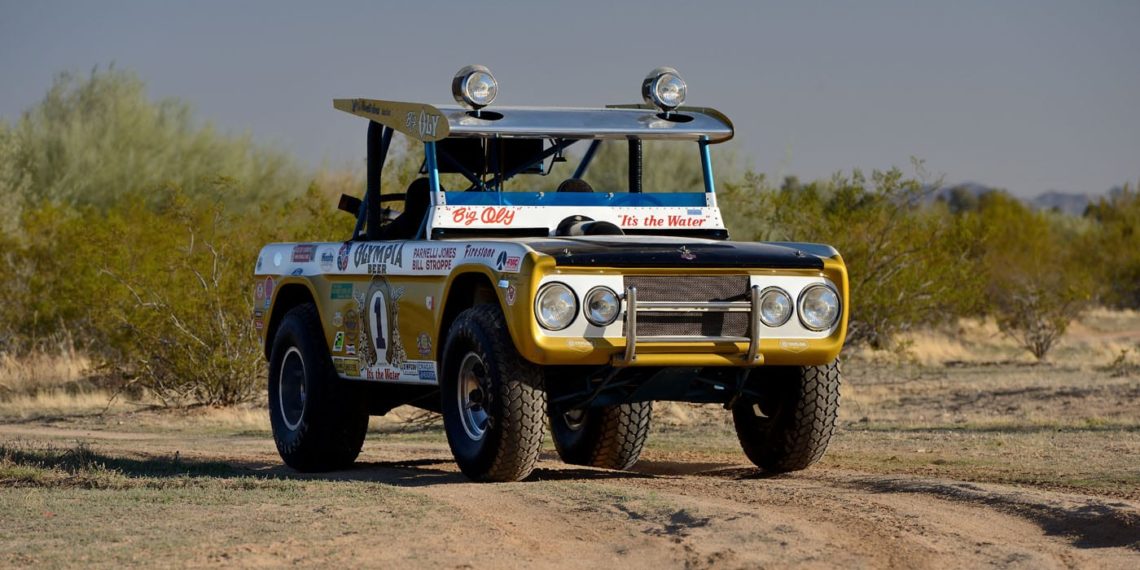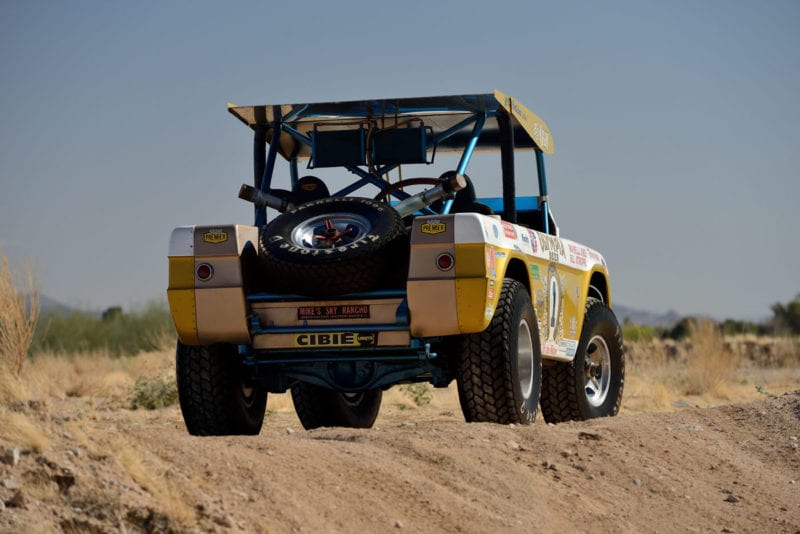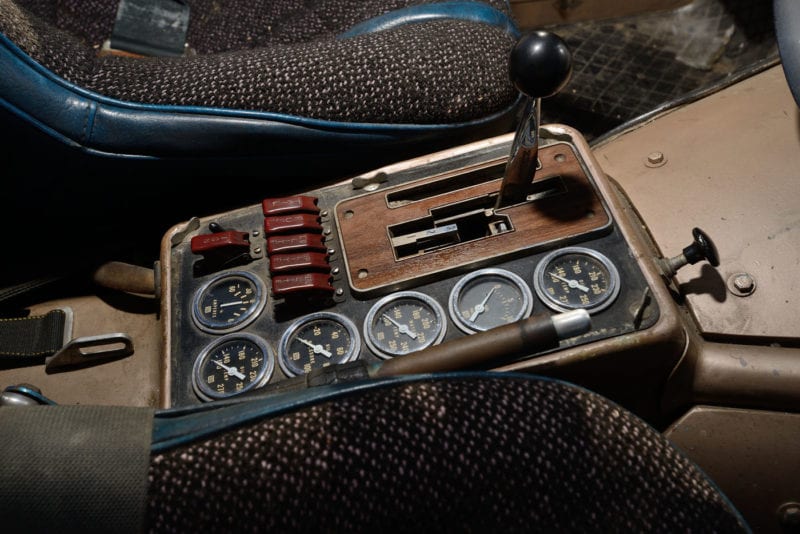Presented by Mecum Auctions – It’s fondly known as “Big Oly”—one very special vehicle that has rightfully earned the moniker of the world’s most famous Ford Bronco—and it’s now slated to cross the Mecum auction block at Dana Mecum’s 34th Original Spring Classic this May 14-22 in Indianapolis. Based on a 1969 Bronco and with sponsorship in place from Olympia Brewing Company, Big Oly is among the most memorable in the history of motorsports. It was driven by the iconic Parnelli Jones, a man who unquestionably enjoyed pet names for his racing vehicles. Jones was made famous driving a car named “Ol’ Calhoun,” his faithful Watson-Offenhauser racer in which he broke the elusive 150 MPH barrier and won the Indianapolis 500. In this case, the name Big Oly certainly fit Jones’ rough and tumble persona.
It all started with a simple dare. Jones was a Ford man. Bill Stroppe was a Ford man. After seeing his share of racing tragedies, Jones had become more selective about what he would race, giving up the Indianapolis 500 after a heartbreaking effort that left him less than four laps from victory in the groundbreaking Andy Granatelli-run STP Turbine. It was Jones’ newfound selectivity that led him to turn down an opportunity to run with Stroppe at the Baja 1000; but Stroppe wasn’t one to take a refusal lightly. He told some friends at a party in late 1967 that “Jones wasn’t man enough for off-road racing.”
“It was like showing a red cape to a bull,” Jones would later say. Stroppe and Jones already had a long and storied history in racing. In 1964, Jones won eight races driving for Stroppe on his way to a USAC Stock Car title and captured back-to-back stock car wins at the Pikes Peak Hill Climb in 1963-64. After an attempt at the Baja 1000 in a mostly stock Bronco in 1968, Jones knew he needed something better to win the event, and he used all the ideas in his fertile mind to come up with what would become the most special Bronco of them all: Big Oly.
Jones shared his innovative ideas with trusted Stroppe mechanic Dick Russell. Russell decided they would take Big Oly to his garage to build a faster and stronger lightweight Bronco with a tube frame and body made of fiberglass and aluminum. Initially, Stroppe was upset at the two for going behind his back. In fact, Jones had to go out of his way to calm Stroppe down. After he cooled his jets and saw the innovative ideas on the unfinished build, Stroppe knew the Bronco had to be completed at his race shop.
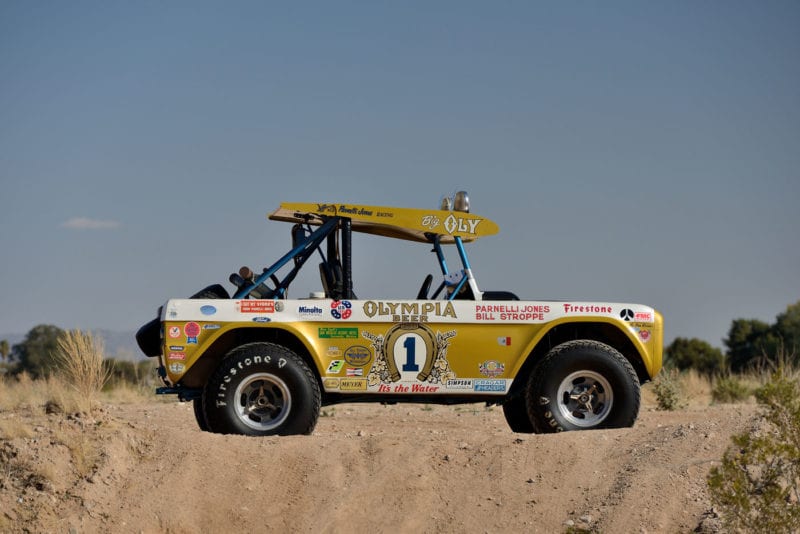
Big Oly forever changed the design principles and construction for off-road racers. Powered by a 351/390 HP Ford Windsor V-8 engine mated to a modified Ford C6 B&M hydro transmission and sporting two 22-gallon fuel cells, it was the stuff of dreams. Featuring a chrome moly space frame, fiberglass and aluminum bodywork with extreme shock absorber and suspension travel, a big wing on top, a split windshield to reduce dust in the cockpit, and a spool rear end for better traction, Big Oly was a sensation right from the beginning. The 154-inch-long, 72-inch-wide vehicle had a dry weight of merely 2,620 pounds, making it lighter than some small sports cars of the day.
The entire build was meant to push boundaries. A roof was required, so why not make it a giant wing? It was an idea that Jones came up with that just happened to precede the common practice on today’s World of Outlaws Sprint Cars. The split windshield was something Jones had used in the past on dirt tracks and thought it would be particularly effective in an off-road setting. He was right. The lightweight and strong materials were derived from the expertise Jones had picked up during his days in Indy Car racing. Big Oly even had two integrated thermos jugs for storing water in order to keep Jones and Stroppe well-hydrated behind the wheel.
By the time Big Oly was ready for its inaugural run at the Baja 1000 in 1970, Jones had become a very successful businessman. He had partnered with his longtime friend Vel Miletich in a Southern California Ford dealership, as well Firestone tire stores and distribution, and the two formed the all-conquering Vel’s Parnelli Jones Racing. The race team won the 1970 and 1971 Indianapolis 500s, captured three consecutive Indy Car championships and, in the next few years, would race at the front of the pack in categories as diverse as Formula 1, Formula 5000, NHRA drag racing, USAC Championship Dirt Cars and Sprint Cars. They were the gold standard of the motorsport world. Baja was clearly not something Jones needed to do, but his competitive spirit to win at everything drove him forward nonetheless.
After breaking an axle in its first try in the 1970 Baja 1000—a race in which Jones admits he simply pushed too hard for the conditions of the course—Big Oly went on to ruthlessly dominate off-road racing for the next few years, winning the Baja 1000 in 1971 and 1972, and the Baja 500 and Mint 400 in 1973. The inaugural win for Big Oly at the Baja 1000 in 1971 was achieved with an amazing time of 14 hours 59 minutes, leaving even the fastest of motorcycles in the dust on the route from Enseda to La Paz in the Mexican peninsula of Baja California. Scoring an overall win in Big Oly was incredible and something that further burnished Jones’ reputation as a man who could win any race, on any course, in any vehicle.
One year later, the race course was changed, as this time the Baja 1000 ran a different route of the Baja California peninsula from Mexicali to La Paz. Big Oly would duplicate its feat of a year ago, but not without some high drama near the finish. In the interest of efficiency, Stroppe had hired some local kids to help with refueling along the way. At the race’s final checkpoint, about 100 miles from the finish, one of the youngsters mistakenly poured gasoline in the one of the thermos jugs. Take one look at the contraptions on the back of Big Oly, and it’s not hard to see why this mistake happened. Realizing what had happened almost immediately, Jones thought he might still make it to the end, but stalled about 15 miles from the finish line. He and Stroppe were stranded, and the situation looked dire.
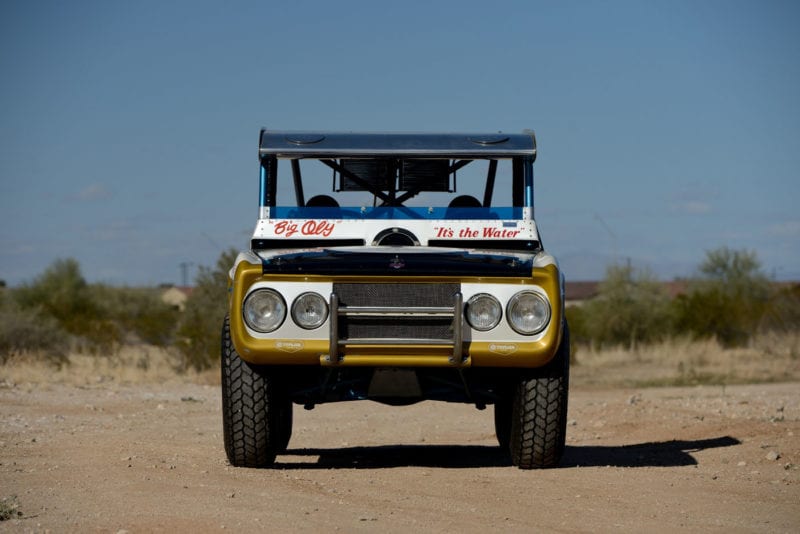
As if from the heavens above, two locals driving a dimly lit Volkswagen happened upon Jones and Stroppe. Jones made a quick deal to buy a bottle of tequila that accompanied them on the journey as well as some gasoline in exchange for a $20 bill. There was much sadness all around, as Jones immediately poured the tequila out onto the dirt. He then took the Volkswagen’s windshield wiper hose and started siphoning gasoline out of its tank into the tequila bottle. After repeating this process about 15 times, it turned out to be enough to get Big Oly going and, to the amazement of everyone, to win the race for a second consecutive year.
Jones’ quick thinking with the tequila bottle was matched by Stroppe’s ingenuity in the form of an analog GPS system. A backlit tablet containing a hand-operated scroll of maps meticulously drawn by prerace runs of the course made by Stroppe, the contraption gave the duo unmatched details about the route. It accomplished most of what a modern GPS system in a car of today does, minus the real-time updates. The analog GPS was a simple but brilliant tool that worked as well at night as it did during the day thanks to its backlit feature.
Big Oly’s string of successes would continue, as it went on to score wins in the Baja 500 and the Mint 400 in 1973. It’s hard to put into words the mental fatigue that sets in on long-distance off-road races, where one simple mistake can undo hours upon hours of fine driving, making the record of Big Oly with Jones and Stroppe nothing short of sterling.
Since those glory days, when Big Oly wasn’t residing at the Vel’s Parnelli Jones race shop, it was out being treated with the regality it deserves. Big Oly has been on display in Ford’s hometown of Dearborn, Michigan, at the Amelia Island Concours d’Elegance and all over its home state of California. In fact, former Mexican president Vicente Fox Quesada once took a seat inside Big Oly, as if to demonstrate just how important the vehicle is in the country where it scored its greatest triumphs.
Driven by one of the most iconic racers in the sport’s history, Parnelli Jones, who teamed with his long-time compatriot Bill Stroppe for all of its big successes, Big Oly stands alone as the world’s most famous Ford Bronco, and it’s now ready for the next chapter in its storied history as it heads for the Mecum auction block this May in Indianapolis.
Big Oly will be auctioned off during Mecum Auctions’ Indy 2021 event, which runs May 14-22.

